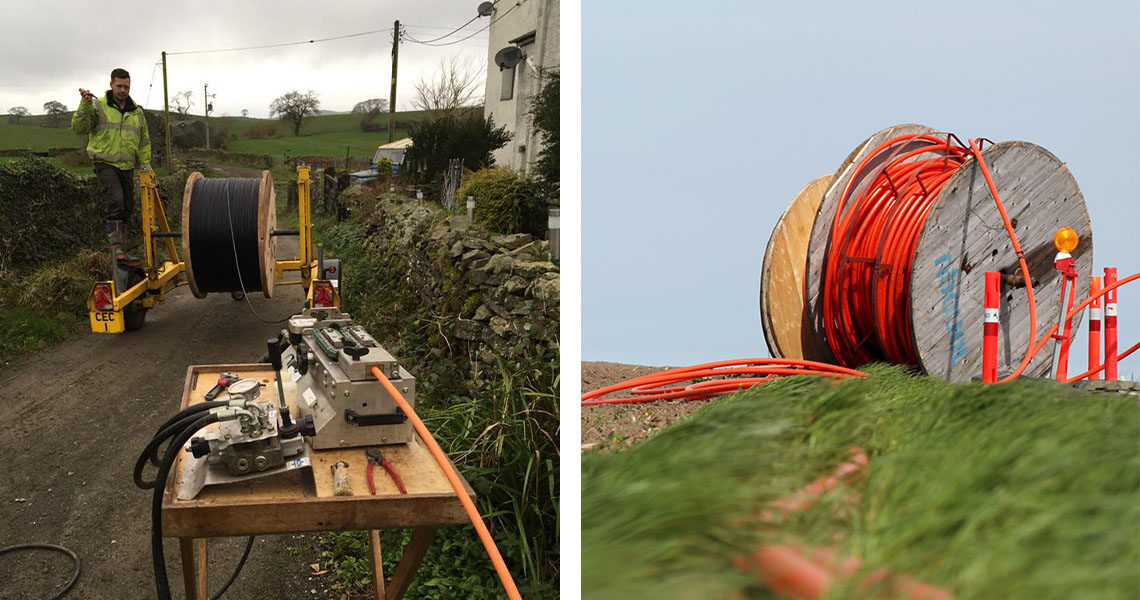Project: 1GB FTTH Broadband connection to subscribers
Location: Kendal, Cumbria, United Kingdom (UK)
Company: Broadband for the Rural North Ltd (B4RN)
Tratos & Broadband for the Rural North Ltd (B4RN) cooperation
Partnering with operator Broadband for the Rural North Ltd (B4RN), Tratos has brought super-fast connectivity to an isolated parish in Cumbria, United Kingdom.
The installation saw a large section (2,000m) of 288 core Tratos Fibre Optic Cable 7.2mm OD round put in place at Old Hutton near Kendal. The team completed the installation in a morning, having previously carried out cable trenching. First connections as part of the upgrade were quickly installed with further phases of connection scheduled to be delivered as part of the ongoing project.
About Broadband for the Rural North
Broadband for the Rural North ‘B4RN’ is an innovative community-led project to bring high-speed broadband Internet connectivity to domestic FTTH and business properties in rural Lancashire, in the north west of England. It functions as an Internet service provider.
‘B4RN’ (pronounced ‘Barn’) was launched in December 2011 by a local volunteer group led by industry expert Barry Forde. Registered as a Community Benefit Society, it can never be bought by a commercial operator and its profits can only be distributed to the community or used to expand the network.
The company’s initial share offering raised hundreds of thousands of pounds from the local community and the first ground was broken in Quernmore in March 2012.
Within months, B4RN’s affordable, community-focused model won it the ISPA’s ‘Internet Hero’ award. By 2015, B4RN had 1000 properties connected and received royal recognition with a visit from HRH The Prince of Wales. B4RN is regularly used as a leading exemplar by national TV and press of what is possible both in terms of gigabit fibre and an empowered rural community.
- B4RN has more than 7,000 connected properties
- B4RN is an equal opportunities employer with more than 50 staff and hundreds of dedicated volunteers
- Uptake of B4RN averages about 65% of all properties in the communities we’ve completed
- Local communities have invested more than £7m in B4RN
- B4RN has more than 2,300 shareholders
FTTH initiative
Tratos is a dedicated supporter of UN Global Goal 9: Build resilient infrastructure, promote sustainable industrialization and foster innovation.
Tratos has long campaigned to remove the dominance of old copper networks, in favour of Fibre to the home Broadband, to allow access for other, more nimble suppliers in the UK.
Tratos is very pleased to support globally the Fibre to the home (FTTH) initiative, which is a powerful enabler of UN Global Goals : GOAL 3: Good Health and Well-being, GOAL 4: Quality Education, GOAL 5: Gender Equality, GOAL 8: Decent Work and Economic Growth, GOAL 9: Industry, Innovation and Infrastructure, GOAL 11: Sustainable Cities and Communities, GOAL 12: Responsible Consumption and Production.
FTTH is the delivery of a communications signal over optical fibre from the operator’s switching equipment all the way to a home or business, thereby replacing existing copper infrastructure such as telephone wires and coaxial cable.
FTTH is one of the most powerful technologies for fixed Internet access:
- It promotes the performance and the reliability of passive infrastructure,
- It offers the fastest and most symmetrical connection speeds,
- It allows the evolution of new Internet uses, multimedia and connected services thanks to speeds much higher than those of ADSL.
Fibre to the home is a relatively new and fast-growing method of providing vastly higher bandwidth to consumers and businesses, and thereby enabling more robust video, internet and voice services.
Connecting homes directly to fibre optic cable enables enormous improvements in the bandwidth that can be provided to consumers. Current fibre optic technology can provide two-way transmission speeds of up to 100 megabits per second. Further, as cable modem and DSL providers are struggling to squeeze increments of higher bandwidth out of their technologies, ongoing improvements in fibre optic equipment are constantly increasing available bandwidth without having to change the fibre. That’s why fibre networks are said to be “future proof.”










